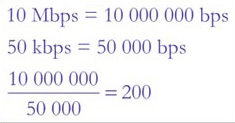3.5 Establishing Ethernet standards
The first Ethernet network was developed in the early 1970s, long before the days of the World Wide Web and personal computers (PCs). It was designed by researchers at the Xerox Palo Alto Research Centre in California, USA to connect the Centre's 'Alto' computers to an office printer.
Ethernet's journey from its modest roots to become the dominant network technology is a fascinating one. One of the main reasons for its success lies with the decision to publish the standard. Standards that are available to anyone in this way are known as open standards.
Activity 13: exploratory
Try to think of a standardised product that you use in your own home. Make some notes about what features of the product are standardised. Why do you think that the availability of open standards helps to establish related products in the marketplace?
Discussion
One simple example of a standardised product that I thought of is the plug that connects my domestic electrical equipment (such as my kettle, hairdryer, table lamps) to the mains electricity supply. In the UK, these plugs have three pins and conform to a standard known as BS1363. BS stands for 'British Standard' and indicates that the standard has been agreed by the British Standards Institute – the national standards body of the UK. BS1363 specifies things like the shape and configuration of the pins, the type of material various parts of the plug should be manufactured from, and the safety features it should possess. Other countries use different standards for their electrical plugs and sockets, so when I travel abroad I generally need an adaptor to use the electrical equipment I take with me.
When a standard is widely available, many different manufacturers are able to produce products that are compatible. This is likely to increase competition and drive down the costs to consumers. It is also likely to increase manufacturers' confidence in the market and so encourages them to invest in and develop products. This in turn is likely to lead to greater reliability.
The standardising body for Ethernet is The Institute of Electrical and Electronics Engineers (IEEE). (You may remember that the article in Section 1, Networked microsensors and the end of the world as we know it, was published by the IEEE.)
The Institute of Electrical and Electronics Engineers (IEEE)
The IEEE was formed from two earlier organisations: the American Institute of Electrical Engineers (AIEE) and the Institute of Radio Engineers (IRE). As technology developed, the boundaries between these two organisations became more and more blurred and eventually, in 1963, they merged. The IEEE is based in the USA but is essentially a global association of professionals working in technical areas such as computing, telecommunications, power engineering and electronics.
When developing standards, it is usual for the IEEE to establish a committee of interested bodies. This committee forms a working group to collaborate and agree on the details of the proposed standard. The working group set up to standardise network technologies took its name from the month and year (February 1980) of its formation, and became known as the '802 working group'. Task forces appointed to work on particular aspects of networking are each identified by a further number. The Ethernet taskforce and Ethernet standards are all identified by IEEE 802.3.
The IEEE 802.3 standard specifies a total data rate of 10 Mbps, but subsequent developments in technology enable faster data rates to be achieved and so new 802.3 standards have been defined, providing data rates of 100 Mbps, 1 Gbps (gigabits per second) or 10 Gbps. These new standards are identified by adding a suffix to the standard number so, for example, the 10 Gbps Ethernet standard is known as IEEE 802.3ae.
I find that it's quite difficult to get a feel for the magnitude of data rates like those I quoted in the previous paragraph. When I meet a very large number, I find it is helpful to compare it with something relevant that I do have a 'feel' for (for example, something I'm familiar with in everyday life). It doesn't have to be an exact comparison – just an estimate helps. The next activity will give you an example of a simple comparison you could make.
Activity 14: exploratory
Estimate how many times faster the data rate of the original Ethernet standard (10 Mbps) is, compared to the data rate of a modern standard dial-up modem of 56 kbps. (Hint: round down the dial-up modem rate to 50 kbps.)
Discussion
We suggested you round down the dial-up modem rate to 50 kbps becomes it then becomes a much easier figure to work with, so this speeds up the calculations. Because only an estimate is required, you don't need to come up with an exact answer, just one that will help you to make a rough comparison.
First we need to express both figures in the same units. Currently one is expressed as Mbps and the other as kbps, so we will express them both in bps.
So the first commercial Ethernet network was about 200 times faster than a modern 56 kbps modem dial-up connection.
Comparisons and estimates are two very useful tools. A comparison with something you are already familiar with can help you to get a feel for new ideas or concepts. (For example, I can get a feel for the size of a hectare once I know it is about the same size as a soccer pitch of international standard.) As well as providing a quick way of making comparisons, estimates can also be useful in checking that the answers you come up with for calculations are sensible.

